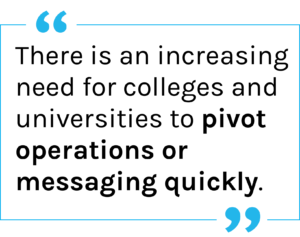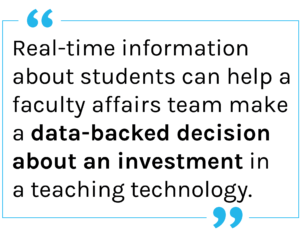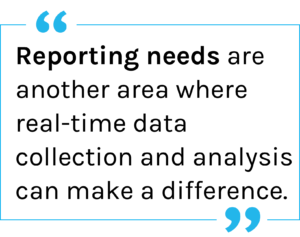Data insights are the future for higher education institutions.

Higher education institutions have almost universally grappled with the changes and challenges of the last few years, including online instruction, faculty burnout, the great resignation, declining enrollment, budget cuts, and increased competition for talent and students. What connects all of these challenges is that overcoming them requires understanding your institution’s data, discovering insights, and using that information to make data-backed, strategic decisions. Flexibility, technology, innovation, and data are among the major trends predicted for higher education in 2022—as your institution is planning for the year, how important is it to weave in data analytics?
We’ve already written about the joint statement about analytics by the Association for Institutional Research (AIR), EDUCAUSE, and the National Association of College and University Business Officers (NACUBO), which notes: “A renewed commitment by higher education’s leaders to the use of analytics can help colleges and universities advance institutional goals, improve quality and efficiency, strengthen student outcomes, and enhance teaching, learning, and advising.” AIR, EDUCAUSE, and NACUBO also emphasize the urgency of implementing a data analytics strategy for institutions who have not yet done so, stating: “The time to act is now.” Read on to learn more about the value of real-time insights for today’s HigherEd landscape.
The right decision, fast
Decision-making processes in higher education often involve committees, encompassing multiple perspectives, and have been criticized as slow-moving. Yet there is an increasing need for colleges and universities to pivot operations or messaging quickly in response to changing health guidance, social unrest, and other factors. Without the right analytic capabilities, however, an institution could be basing these urgent decisions on incomplete or outdated information, leaving the path forward shaky. This is where real-time data insights can make the difference, ensuring that all involved have the most updated and accurate information to inform a strategic move.
health guidance, social unrest, and other factors. Without the right analytic capabilities, however, an institution could be basing these urgent decisions on incomplete or outdated information, leaving the path forward shaky. This is where real-time data insights can make the difference, ensuring that all involved have the most updated and accurate information to inform a strategic move.
Even when a decision is less urgently needed, real-time insights can provide a push to speed up the debate. When dealing with data that is already dated, it can be difficult to want to rush to a conclusion—but when the information is fresh, it makes sense to act fast.
Real-time helps everyone. Really.
Access to real-time data insights doesn’t just help leadership teams, but everyone on campus—including HR, admissions, advancement offices, faculty, and students. HR and admissions offices can leverage real-time data analytics to understand the success of their recruitment initiatives, and combine that data with predictive analytic models to hone recruitment methods, focus on the right candidates, and increase staff and student retention. The University of Central Florida is using real-time and predictive analytics to understand trends in alumni donations, giving the advancement office access to vital insights to inform their strategy.

Faculty can also benefit greatly from real-time data. Access to attrition rates and student performance information throughout a semester can inform instructional design, meaning that courses are designed and redesigned based on the needs of current students, rather than historical or anecdotal information. Similarly, real-time information about student attendance or grades can help a faculty affairs team make a data-backed decision about an investment in a teaching technology being tested by a faculty member.
Student success is a central part of the importance of real-time data. When your institution is tracking real-time signals of student engagement and behavior, it’s easier for faculty members and advisors to understand curriculum effectiveness or catch a student at risk of failing. Rather than relying on end-of-semester results, real-time data means that faculty can change directions in the middle of the semester to provide more effective instruction for the students in their current section. Instead of relying on current students to inform the teaching of future students, faculty can rely on the students to inform their teaching methods today.
Accurate reporting keeps you competitive
With many colleges and universities continuing to experience lower application rates and struggling to retain students, there’s no question that the landscape of higher education is increasingly competitive. As Ellucian writes, higher competition means that “institutions are faced with more pressure to report and account for how their people, programs, and assets perform. This creates an environment of heightened accountability, where organizations are expected to answer questions across a range of processes, identify and anticipate trends, and work as one institution to change and grow.”
Reporting needs are another area where real-time data collection and analysis can make a huge difference. Colleges and universities can offer up-to-date information about the success of DE&I initiatives, report on how students are performing in a class that pivoted to remote, or quantify the benefit of a newly launched work-study program. Speaking to stakeholders, potential employees, or future students about the things happening on campus now, rather than a year ago, can make the difference in how they view your institution.
up-to-date information about the success of DE&I initiatives, report on how students are performing in a class that pivoted to remote, or quantify the benefit of a newly launched work-study program. Speaking to stakeholders, potential employees, or future students about the things happening on campus now, rather than a year ago, can make the difference in how they view your institution.
Get your whole campus involved
The time to leverage real-time insights is now. PeopleAdmin can help you connect your entire campus, bringing disparate processes and departments together and ensuring that everyone has access to the same accurate, up-to-date information so that they can make the right decisions. Real-time analytics can’t happen if your institution is still using manual processes – being reliant on excel documents or other homegrown methods means that teams lose hours on data manipulation, or decisions are made based on out-of-date data, or are not based on data at all. Your analytics solution has to be digital, reliable, and scalable to eliminate campus silos and create cross-campus partnerships. Learn more about how PeopleAdmin can enable strategic decision-making on your campus.